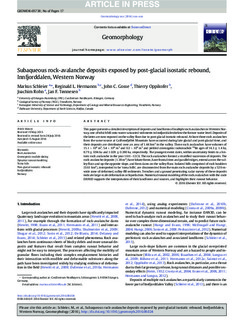| dc.description.abstract | This paper presents a detailed description of deposits and landforms of multiple rock avalanches in Western Norway, one of which fell onto water-saturated sediments in Innfjorddalen below the former water level. Deposits of the latter are now exposed on the valley floor due to post-glacial isostatic rebound. At least three rock avalanches from the same source at Gråfonnfjellet Mountain have occurred during late glacial and post-glacial time, and their deposits are distributed over an area of 1.44 km2 in the valley. These rock avalanches have volumes of 15.1 × 106 m3, 5.4 × 106 m3 and 0.3 × 106 m3 and yielded cosmogenic radionuclide 10Be ages of 14.3 ± 1.4 ka, 8.79 ± 0.94 ka and 1.028 ± 0.380 ka, respectively. The youngest event dates, within uncertainty limits to a historic rock avalanche in the year 1611–12 CE. The rock avalanches formed a stratified succession of deposits. The rock-avalanche deposits (1.38 m2) have lobate forms, have frontal rims and parallel ridges, extend across the valley floor and up the opposite slope, and form dams on the valley floor. Isolated hills comprised of rock boulders (0.61 km2), interpreted to be ‘toma hills’, are disconnected from the main rock-avalanche deposits by a 520-m-wide zone of deformed, valley-fill sediments. Trenches and a ground penetrating radar survey of these deposits indicate large-scale deformation or liquefaction. Numerical runout modeling of the rock avalanches with the code DAN3D supports the interpretation of their landforms and sources, and highlights their runout behavior. | nb_NO |
